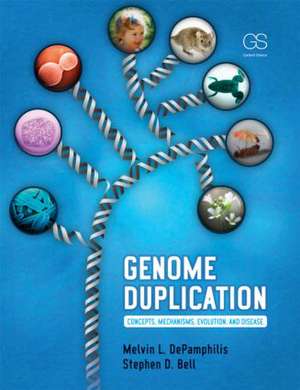Genome Duplication
Autor Melvin DePamphilis, Stephen Bellen Limba Engleză Paperback – 6 oct 2010
Using examples from the three domains of life - bacteria, archaea, and eukarya - Genome Duplication shows how all living organisms store their genome as DNA and how they all use the same evolutionary-conserved mechanism to duplicate it: semi-conservative DNA replication by the replication fork. The text shows how the replication fork determines where organisms begin genome duplication, how they produce a complete copy of their genome each time a cell divides, and how they link genome duplication to cell division.
Genome Duplication explains how mistakes in genome duplication are associated with genetic disorders and cancer, and how understanding genome duplication, its regulation, and how the mechanisms differ between different forms of life, is critical to the understanding and treatment of human disease.
Preț: 495.57 lei
Preț vechi: 656.28 lei
-24% Nou
Puncte Express: 743
Preț estimativ în valută:
94.84€ • 98.26$ • 79.15£
94.84€ • 98.26$ • 79.15£
Comandă specială
Livrare economică 01-15 martie
Doresc să fiu notificat când acest titlu va fi disponibil:
Se trimite...
Preluare comenzi: 021 569.72.76
Specificații
ISBN-13: 9780415442060
ISBN-10: 0415442060
Pagini: 476
Ilustrații: 243 color images, 69 tables, 14 halftones, 44 color halftones and 185 color line drawings
Dimensiuni: 219 x 276 x 23 mm
Greutate: 1 kg
Ediția:New.
Editura: CRC Press
Colecția Garland Science
ISBN-10: 0415442060
Pagini: 476
Ilustrații: 243 color images, 69 tables, 14 halftones, 44 color halftones and 185 color line drawings
Dimensiuni: 219 x 276 x 23 mm
Greutate: 1 kg
Ediția:New.
Editura: CRC Press
Colecția Garland Science
Public țintă
Postgraduate, Professional, and UndergraduateCuprins
1. Genomes
2. Three Domains of Life
3. Replication Forks
4. Replication Proteins: Leading-Strand Synthesis
5. Replication Proteins: Lagging-Strand Synthesis
6. Termination
7. Chromatin Assembly, Cohesion, and Modification
8. Replicons
9. Replication Origins
10. Origin Paradigms
11. Initiation
12. Cell Cycles
13. Checkpoints
14. Human Disease
15. Evolution of Cellular Replication Machines
2. Three Domains of Life
3. Replication Forks
4. Replication Proteins: Leading-Strand Synthesis
5. Replication Proteins: Lagging-Strand Synthesis
6. Termination
7. Chromatin Assembly, Cohesion, and Modification
8. Replicons
9. Replication Origins
10. Origin Paradigms
11. Initiation
12. Cell Cycles
13. Checkpoints
14. Human Disease
15. Evolution of Cellular Replication Machines
Recenzii
"...an accessible work that undergraduate students in their first molecular genetics class can easily read and understand. At the same time, this book has much to offer graduate students and researchers in the field. Many excellent tables summarize the information in each chapter. The volume also includes a glossary, clear illustrations, and chapter references." - Klevickis, C.A., CHOICE, April 2011
"This book will be very informative for a wide audience—population biologists, molecular epidemiologists, and ecology/evolution instructors, as well as graduate students."
- The Quarterly Review of Biology
"This book will be very informative for a wide audience—population biologists, molecular epidemiologists, and ecology/evolution instructors, as well as graduate students."
- The Quarterly Review of Biology
Notă biografică
DePamphilis, Melvin; Bell, Stephen
Descriere
This comprehensive and readable overview provides an excellent starting point for undergraduate and graduate students.
Using model organisms from the three domains of life (Bacteria, Archaea, and Eukarya), Genome Duplication describes the principal molecular mechanisms of DNA replication and shows how the process is linked to cell division. This approach allows the authors to shed insight into how genome duplication has evolved, and how its regulation is relevant to the understanding and treatment of human disease, especially cancer.
Using model organisms from the three domains of life (Bacteria, Archaea, and Eukarya), Genome Duplication describes the principal molecular mechanisms of DNA replication and shows how the process is linked to cell division. This approach allows the authors to shed insight into how genome duplication has evolved, and how its regulation is relevant to the understanding and treatment of human disease, especially cancer.
